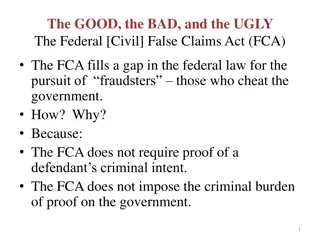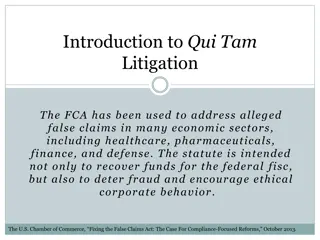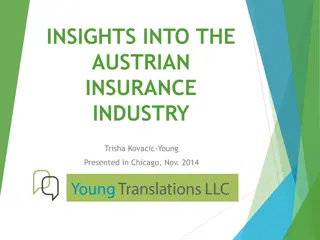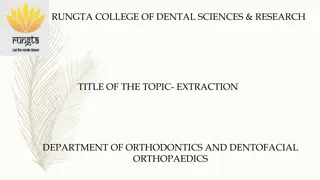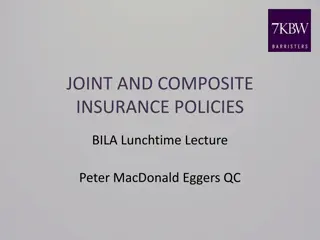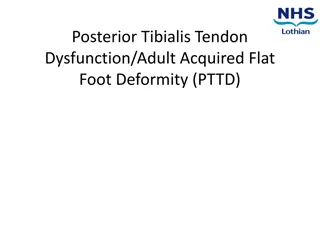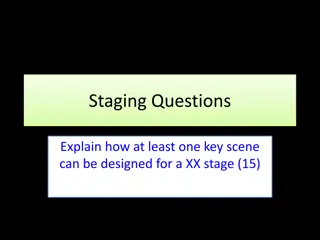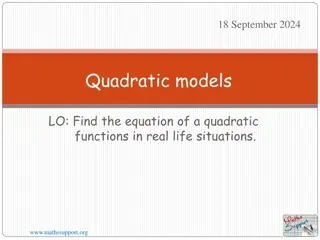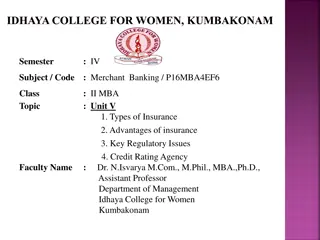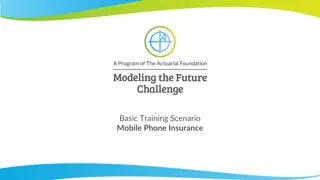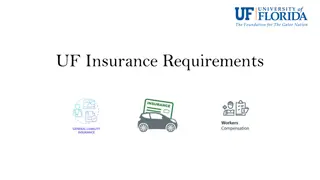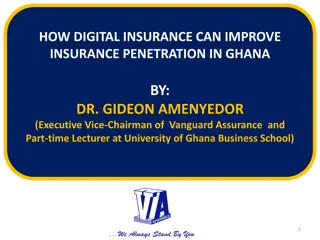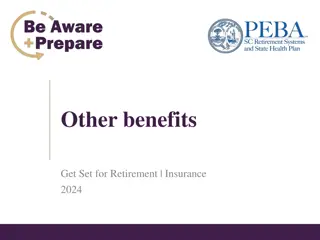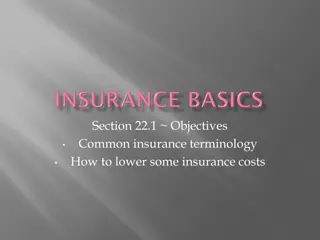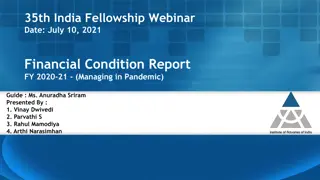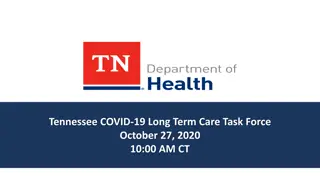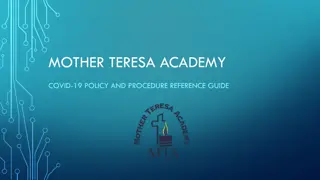Analysis of FCA v. Arch Insurance Case: COVID-19 Impact on Insurance Policies
The case of Financial Conduct Authority v. Arch Insurance highlights the legal implications of COVID-19 on insurance policies, focusing on trigger of cover clauses, relevant background regulations, objectivity principle in contractual construction, trends clauses, and the counterfactual assessment. Key issues include disease clauses, hybrid clauses, and clauses covering prevention of access due to the pandemic. Legal precedents like Orient-Express Hotels Ltd. v. Assicurazioni Generali SpA are referenced in the analysis.
Uploaded on Oct 08, 2024 | 0 Views
Download Presentation

Please find below an Image/Link to download the presentation.
The content on the website is provided AS IS for your information and personal use only. It may not be sold, licensed, or shared on other websites without obtaining consent from the author. Download presentation by click this link. If you encounter any issues during the download, it is possible that the publisher has removed the file from their server.
E N D
Presentation Transcript
Financial Conduct Authority v Arch Insurance and Financial Conduct Authority v Arch Insurance and Others Others [2020] EWHC 2448 (Comm) Professor Rob Merkin Dr zlem G rses
Focal issues Trigger of cover independent of physical damage 21 policies falling into three broad categories: (i) Disease Clauses ; (ii) Hybrid Clauses ; and (iii) clauses covering prevention of access and similar perils.
Relevant background Regulations: The closure of pretty much all businesses and facilities offering goods and services to the public. Regs permit the detention and screening of persons suspected to have COVID-19. advice against the holding of large gatherings. 10 Feb. 2020 16 Mar. 2020 26 Mar. 5 Mar. 24 Mar. COVID-19: COVID-19 was made a notifiable disease holiday accommodation providers were told to close their premises for commercial use and on
The objectivitiy principle (so that subjective views are excluded) Contractual construction A term is not to be taken isolation but must be construed in context Only circumstances known to the parties when the contract was made are material.
Trends clause Look backwards to see how the business had performed before the occurrence of the insured peril Trends clause: allows the Court to take account of exceptional events that may have depressed or increased revenue in the earlier comparator, and also to take account of anticipated exceptional events in the indemnity period. Standard Gross Revenue adjustments shall be made as may be necessary to provide for the trend of the Business .
Counterfactual What would have happened but for the occurrence of the insured peril. Strip out from the counterfactual all elements of the insured peril whether the disease or the lockdown or both. The relevant comparator: the difference between what would have earned but for the insured peril (including the disease) and what was actually earned in the indemnity period. Orient-Express Hotels Ltd v Assicurazioni Generali SpA [2010] Lloyd s Rep IR 531 DISTINGUISHED New World Harbourview Hotel v Ace Insurance [2012] Lloyd's Rep IR 537
Disease Clauses: fixed locality I Disease Clauses: fixed locality I RSA 3 interruption of or interference with the Business during the Indemnity Period following any occurrence of a Notifiable Disease within a radius of 25 miles of the Premises There will have been an occurrence of COVID-19 within an area when at least one person who was infected with COVID-19 was in the relevant area Such a Disease thus occurs when the illness is sustained by a person, ie, that they are suffering from it, not that they have been diagnosed with it. Follow : a looser link than the but for test sufficed Local outbreaks could not be separated from the overall national outbreak If there was an occurrence within the 25-mile radius and there was a lockdown the cover applied
General Exclusion L in RSA 3 The insurance by this Policy does not cover any loss or Damage due to epidemic and disease . This exclusion was included without detailed consideration The policy provided : All other terms and conditions of this Policy shall be unaltered and especially the exclusions shall not be superseded by this clause The court was willing to apply the contra proferentem principle
Disease clauses: fixed locality II Disease clauses: fixed locality II The MS Amlin 1-2 policy wordings were much the same as RSA 3 we will pay you for consequential loss as a result of interruption of or interference with the business carried on by you at the premises following any notifiable disease within a radius of twenty five miles of the premises
Disease clauses: fixed locality II Disease clauses: fixed locality II Argenta policies, applied to holiday accommodation. interruption as a result of any occurrence of a notifiable human disease within a radius of 25 miles of the premises. a local outbreak encompassed in a national response satisfies the clause Expresses: there being the disease within the 25 mile radius proximate cause: the occurrence of the disease within the area was a part of an indivisible cause, or, in the alternative, that each of the cases of the disease was an independent cause, equally effective in producing the government response.
Disease clauses: fixed locality III Disease clauses: fixed locality III whether the interruption had to be the result of the disease in the agreed radius or whether it sufficed that there were occurrences outside the radius. QBE 1 : interruption of or interference with the business arising from any human infectious or human contagious disease an outbreak of which the local authority has stipulated shall be notified to them manifested by any person whilst in the premises or within a twenty five (25) mile radius of it
QBE 1 manifested required a display of symptoms or a diagnosis The arising from test applied to the link between the interruption or interference with the business and a notifiable disease manifested by a person within a 25 mile radius It did not require the interruption or interference to be the result of the particular case manifested within a 25 mile radius.
QBE 2 Loss resulting from interruption of or interference with the business in consequence of the following events one of which was any occurrence of a notifiable disease within a radius of 25 miles of the premises The interruption is required to be the result of that event. A distinction is to be drawn between the consequences of specific cases within the radius and the consequence of other cases.
Disease clauses: vicinity Disease clauses: vicinity RSA 4 interruption or interference to the Insured's Business as a result of Notifiable Diseases occurring within the Vicinity of an Insured Location, during the Period of Insurance ? Where a disease was of a such a nature that any occurrence in England and Wales would reasonably be expected to have an impact on assureds and their businesses, all occurrences of COVID-19 were within the relevant Vicinity . In any event there was cover for the effects of a Notifiable Disease that had come within the vicinity. a link within the definition of the insured peril; and accordingly not between the loss and the insured peril
Hybrid clauses I Hybrid clauses I Hiscox 1-3 (nightclubs) financial losses resulting solely and directly from an interruption to your activities caused by . your inability to use the insured premises due to restrictions imposed by a public authority during the period of insurance following .an occurrence of any human infectious or human contagious disease, an outbreak of which must be notified to the local authority. Mandatory and not advisory restrictions Inability to use: inability to put them to all of their normal uses
Hiscox 4 financial losses resulting solely and directly from an interruption to your business caused by . your inability to use the insured premises due to restrictions imposed by a public authority during the period of insurance following .an occurrence of a notifiable human disease within one mile of the business premises. A disease had a national impact, and unless there was clear wording to the contrary it was appropriate to regard a response as having followed the local occurrence.
RSA 1 and 4 (cottage owners) RSA 1 and 4 (cottage owners) Loss as a result of closure or restrictions placed on the Premises as a result of a notifiable human disease manifesting itself at the Premises or within a radius of 25 miles of the Premises. The closure or restrictions should be mandatory : enforced closure v advisory closure If a person displayed the symptoms and/or was diagnosed, then there would be manifestation of the disease Whether the disease had manifested itself close to the premises, and if so then a national response based upon all manifestations brought the clause into play.
Prevention of access I Prevention of access I food retailers, pharmacies, petrol stations, banks, medical or other health services reduction in Turnover and increase in cost of working as insured under this Section resulting from prevention of access to The Premises due to the actions or advice of a government or local authority due to an emergency which is likely to endanger life or property. Prevention v hindrance Anything short of complete closure will not constitute prevention of access. the business was solely that of a restaurant, and after the government restrictions operated only as a takeaway there was a pre-existing takeaway, carried on the insured business.
Prevention of access II Prevention of access II churches, parish councils, charities and educational establishments loss resulting from interruption of or interference with your usual activities as a result of access to or use of the premises being prevented or hindered by any action of Government Police or Local Authority due to an emergency which could endanger human life or neighbouring property. There was an exclusion for closure or restriction in the use of the premises due to the order or advice of the competent local authority as a result of an occurrence of an infectious disease. NO cover
Prevention of access III Prevention of access III We will insure you for your financial losses resulting solely and directly from an interruption to your activities caused by an incident occurring during the period of the insurance within a one mile radius of the insured premises which results in a denial of access or hindrance in access to the insured premises, imposed by any civil or statutory authority or by order of the government or any public authority, for more than 24 consecutive hours. An incident was not the same as widespread danger Incident should be given the same essential meaning as an event : something which happens at a particular time, at a particular place, in a particular way A narrow, localised cover. No cover in respect of BI losses caused by the restrictions imposed by the government in response to the national pandemic.
Prevention of access IV Prevention of access IV for the retail and leisure industries (MSA) Loss resulting from interruption of or interference with your business because of action by a competent public authority following threat or risk of damage or injury in the vicinity of the premises which will prevent or hinder use of the premises or access to them. closure of the premises is sufficient to amount to access being prevented, even if the policyholder could still physically access the premises for other purposes than carrying on the business, such as essential maintenance (Zurich) Action by the police or other competent local, civil or military authority following a danger or disturbance in the vicinity of the premises whereby access thereto will be prevented The government action in imposing the Regulations in response to the national pandemic cannot be said to be following a danger in the vicinity, in the sense of in the neighbourhood, of the insured premises.
Prevention of access V Prevention of access V the actions or advice of a competent Public Authority due to an emergency likely to endanger life or property in the vicinity of the Premises which prevents or hinders the use or access to the Premises. Localised cover. There had to be an emergency in the vicinity of the premises, eg, a police cordon following a bomb threat.
Proof of COVID-19 in the locality of the insured premises The Court s interpretation of the policies requires at least one case of COVID-19 in the locality of the insured premises Statistics, but are they fully reliable? The Court in FCA did not come to any conclusion but noted that Equitas Ltd v R&Q Reinsurance Company (UK) Ltd [2009] EWHC 2787 (Comm) Proof by actuarial modelling, accepting the least favourable model to the claimant.
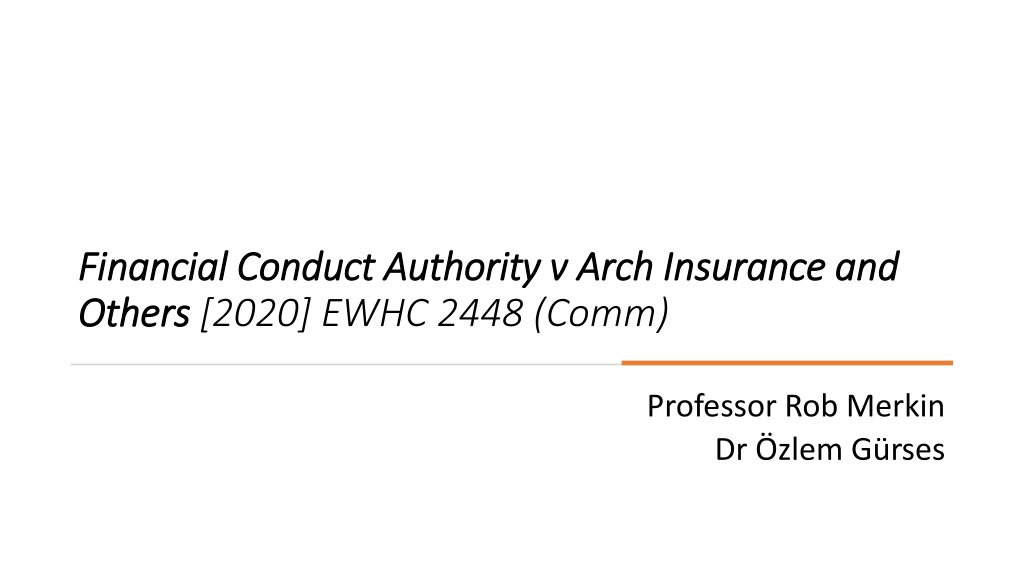

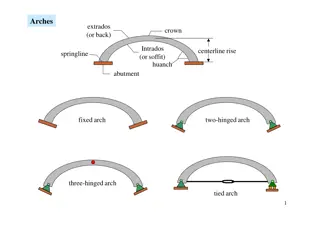
![Legal Dispute Analysis: FCA v ARCH and Others [2021] UKSC 1](/thumb/189783/legal-dispute-analysis-fca-v-arch-and-others-2021-uksc-1.jpg)
